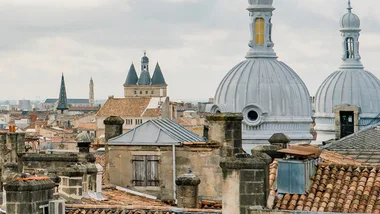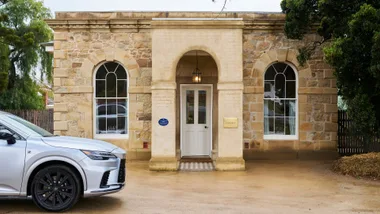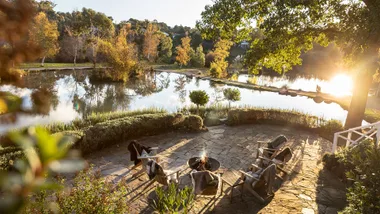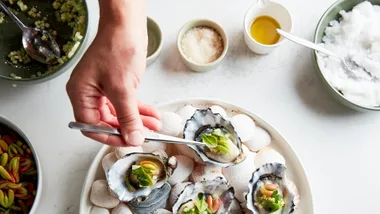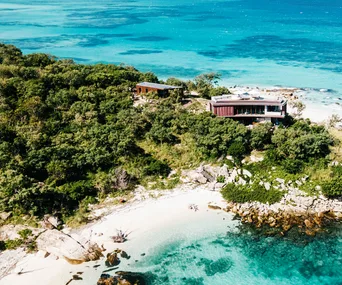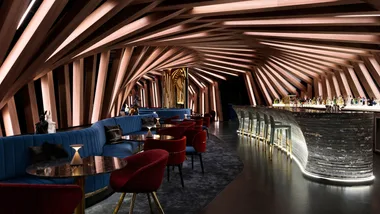EAT AND DRINK
Blind Tiger Pub
Eat share plates and oysters, but prepare to be trampled on nights when the Clemson Tigers football team plays Alabama’s Crimson Tide. 36-38 Broad St, +1 843 872 6700, blindtigerchs.com
Callie’s Hot Little Biscuit
Order the buttermilk biscuits stuffed with ham or black pepper bacon for breakfast. 476 1/2 King St, +1 843 737 5159, calliesbiscuits.com
Edmund’s Oast
Focus on the house beers first at this craft brewery then get acquainted with other small-batch brews on its extensive bottle and tap lists. 1081 Morrison Dr, +1 843 727 1145, edmundsoast.com
Harold’s Cabin
Order the Salty Racoon, a tequila-based “porch pounder” with smoked local sea salt. Pair with hushpuppies. 247 Congress St, +1 843 793 4440, haroldscabin.com
High Wire Distillery
Tastings and tours offered Thursday to Saturday. Don’t miss the Revival Sorghum Whiskey – the smoothest drink in town. 652 King St, +1 843 755 4664, highwiredistilling.com
Husk
The spot that put Sean Brock on the culinary map. Try the skillet cornbread, oysters and ham. 76 Queen St, +1 843 577 2500, huskrestaurant.com
McCrady’s
Brock’s latest flight of fancy, every bite a lesson in locavore creativity. Herbs are sourced from McCrady’s rooftop garden. Set menu; reservation only. 155 East Bay St, mccradysrestaurant.com
Rodney Scott’s BBQ
The newest barbecue in town by a celebrated pitmaster. Unlikely you’ll need the whole hog, but line up for the pulled pork sandwiches. 1011 King St, +1 843 990 9535, rodneyscottsbbq.com
The Cocktail Club
A second-floor lounge that specialises in punch bowls. 479 King St, +1 843 724 9411, thecocktailclubcharleston.com
Xiao Bao Biscuit
Asian soul food that’ll open your eyes to the New South and its edible diversity. 224 Rutledge Ave, xiaobaobiscuit.com
SHOP
Croghan’s Jewel Box
Lowcountry rice spoons, antique jewellery and more. 308 King St, +1 843 723 3594, croghansjewelbox.com
Charleston Farmers
Market Every Saturday from April until November, farmers and food vendors share the Lowcountry bounty. The fun begins at 8am. Marion Square, +1 843 724 7305, charlestonfarmersmarket.com
STAY
Belmond Charleston Place
Michelle Weaver is one of Charleston’s best-loved chefs; order her pickled oysters in the hotel’s Charleston Grill. 205 Meeting St, +1 843 722 4900, belmond.com
The Spectator Hotel
Modern Southern hospitality – don’t miss cocktail hour with bartender Allen Lancaster. 67 State St, +1 843 724 4326, thespectatorhotel.com
Wentworth Mansion
The rooftop cupola is a spectacular spot for sunset cocktails with one of the best skyline views of the city. 149 Wentworth St, +1 888 466 1886, wentworthmansion.com
Cutting across Chalmers Street with my cousin Baby Jane, a tattooed, pierced acupuncturist with a penchant for flip-flops and yoga pants, we bump into a couple of her former schoolmates, who give her the condescending up-and-down perfected by a certain class of impeccably coiffed Southern women. During an achingly sweet exchange of pleasantries, Baby Jane stumbles through an apology of her informal attire, and as they totter away on spiked heels, the two of us are left standing there aghast.
“Don’t let those South of Broad snobs psych you out,” I say. “They’re just wannabes.”
Some things in Charleston never change. And then, some things do.

Charleston’s Broad Street and the historic St Michael’s Episcopal Church (on the left)
The South Carolina city was founded in 1670 at the tip of a peninsula jutting into the Atlantic Ocean, an ideal port location bounded on either side by the Cooper and Ashley rivers, surrounded by vast tidal marshlands, barrier islands and forests of loblolly pine that collectively became known as the Carolina Lowcountry. Colonial plantations produced bountiful rice and cotton crops, which in turn established an élite. They built imposing townhouses, churches, theatres and markets; they entertained lavishly at cotillions and balls; they hunted wild game in winter and retreated to the mountains or beach during the swampy heat of summer. It was an insular society both mythologised and caricatured, founded on an untenable trade in human beings. Real life in antebellum Charleston was closer to 12 Years a Slave than Gone with the Wind. By the late 19th century, following the American Civil War and the abolition of slavery, the party was over. Charleston’s glamour faded for more than a century. Many mansions and other grand institutions fell into neglect, giving rise to the local expression: “Too poor to paint, too proud to whitewash”.

Cycling in South of Broad
By the time my grandmother hauled me down here from New York to spend summer vacations with her sisters in the 1970s, Charleston was so sleepy that my uncles would stroll home from their offices on Broad Street, that demarcation of gentility, for their midday meal and a nap that lasted until cocktail hour. Few had the money to splurge on restaurants and, quite frankly, decent places for a fancy meal skewed to Continental pretension. Lowcountry cuisine wasn’t celebrated. Shrimp and grits was what you cooked for breakfast, not elevated to heavenly manna.
While New Orleans had jazz and Memphis had blues, Charleston had music that accompanied church sermons. No one bought art, but they clung fiercely to their heirloom silver patterns and other material pedigrees. The rules of deportment at the time were designed to stifle a rebellious grandchild who favoured denim over débutante aspirations. My grandmother scolded me on a regular basis about the proper attire to wear in public. It’s a wonder that I ever wanted to come back. But, like I said, some things change.

Shrimp and grits at Husk
The transformation began with the advent in 1977 of Spoleto, a spin-off of the festival in Italy. Music and performance-art aficionados poured in. Garden tours picked up. So did the real estate market, as Northerners with deep pockets snapped up, and spruced up, historic houses on The Battery and the maze of charming alleys directly behind it. Then cruise ships disgorged passengers who wanted a carriage ride on quaint cobbled streets scented with jasmine and crêpe myrtle. The new Cooper River bridge, a modernist cable-stayed span opened in 2005, finally replaced the rickety loop-de-loop of my childhood, which once provided endless thrills (and shrieking) when my great-aunts drove us to the beach at Sullivan’s Island. Native son Darius Rucker of the short-lived ’90s phenomenon Hootie & the Blowfish was discovered singing in the shower of his dorm at the University of South Carolina. Comedian Stephen Colbert grew up playing Dungeons & Dragons on East Bay Street. An incoming chef from Virginia coal country opened a restaurant called Husk.

Chef Sean Brock (far right) and team in the open kitchen at McCrady’s
When I peel off from Baby Jane to meet Sean Brock, he’s already sitting at the high walnut table in McCrady’s, his newest dining room, where vibrant paintings of Lowcountry marsh hang on the exposed brick walls. Stocky and apple-cheeked, he famously sports a full-sleeve tattoo of heirloom crop varieties, many of which he personally encouraged regional farmers to grow again. Brock has been credited with helping to revive endangered hog breeds, and may also be personally responsible for inflating the price of rare bourbons. He’s an obsessive who rummages in rural liquor stores for overlooked bottles of Pappy Van Winkle and Old Fitzgerald. With his business partners, he also opened a branch of Husk in Nashville and a Mexican cantina chain called Minero. In less than a decade, his staff has spread the New South gospel to a wider audience – Morgan McGlone of Belle’s Hot Chicken in Melbourne and Sydney, for instance, is a graduate of his kitchen. It doesn’t matter to me that Brock is “from off”, as Charlestonians refer to anyone not born on the peninsula. Why is it that newcomers to a community most clearly perceive its value? Brock proved that the first time he served me a cast-iron skillet of Anson Mills cornbread sizzling with Benton’s bacon crackling. It’s what baby corn wants to be when it grows up.
“When I was 19, I bought a copy of The Carolina Housewife and became fascinated with this culture and cuisine,” says Brock. “It was so drastically different from the hillbilly cooking I grew up eating.”

McCrady’s
Husk sticks to Lowcountry staples that appeared on my own grandmother’s table – pimiento cheese, field peas, country ham, fried chicken – and Brock still eats fried cabbage and crab rice at Bertha’s Kitchen or Nana’s Seafood, two of the city’s better-known home-cooking spots, but the set menu at McCrady’s is the next step in Brock’s evolution. “It’s always been a dream of mine to do this in the South – coming up with these 16 dishes that speak of things I’m trying to pass along. This is where I belong; this is the emotion I’ve been trying to chase as a cook.”
Those who have dined at Noma or Eleven Madison Park know the modernist drill. A progression of intellectualised bites accompanied by enlightening murmurs from kitchen acolytes. So how does that play out here in Charleston? Yes, there’s eggplant jerky perched in a bonsai. A curl of beet lacquered with cocoa and yuzu skewered on a flower frog. At the communal table in the 22-seat restaurant during dinner service later that night, as the brigade toils in a gleaming steel galley, I consider how removed this experience is from childhood suppers where my grandmother and her sisters devilled crabs and stewed lima beans in a pound of butter. When my waiter places a quenelle of plain white rice dappled with flowers and herbs in front of me, I laugh aloud. Charlestonians still worship the grain that put this city on the trade map, although it’s usually smothered in chicken gravy.

Rice, herbs and flowers, aka Charleston ice-cream
Then he says something that makes me squint in disbelief: “This dish is called Charleston ice-cream, because of the texture of the rice. And it’s served with stone crab from a fisherman who only supplies us.”
“Stone crab?” I ask. “Since when is stone crab local?”
“He catches it right off the harbour.”
I had no idea. And that gives me food for thought about my ancestral backyard.
At the weekend farmers’ market the next morning in Marion Square, I troll past stands selling the same heirloom cornmeal used at Husk, salt produced on one of the Sea Islands off the coast, buttermilk biscuits fully loaded with fried chicken tenders.

Charleston Farmers Market at Marion Square
“Baby, you want to try those before buying them?”
Being called “baby” by the boiled-peanut man is the best thing, especially when he says it with a grin and a Gullah accent. I can’t resist a soggy bag of these unroasted goobers, drowned in hot salty water until soft as mushy peas. They’re an acquired taste, but make an ideal pairing with the syrupy carbonated drinks for which the South is famed. (That’s the long way of saying Coke.) I buy them to hear the peanut man talk. Gullah is a Creole dialect specific to the Lowcountry. If you weren’t raised with it in your ear, the sing-songy speech pattern is almost cryptic. But for those who have, it’s like turning a corner and knowing you’re closer to home. Gullah is also a singular culture, by way of West Africa, that grew out of slavery and gave us gospel music and soulful food.
Last year, Gullah artist Jonathan Green designed the costumes for a new production of George Gershwin’s Porgy and Bess at the Gaillard Center during Spoleto. His colourful paintings of wind-tossed laundresses, preachers and shrimpers capture a rural existence endangered by coastal development. At his private studio on Market Street, the greying, poised artist shows me his rice series, which documents field labour for the long-grain Carolina Gold – the same creamy variety Brock serves at Husk and McCrady’s – that helped to create South of Broad society. Green tells me it’s also what his own grandmother cooked for him. He’s a co-creator of the Lowcountry Rice Culture Project, which examines the more unsavoury history of rice cultivation and its complex legacy.

Ribs, pulled pork, baked beans and collard greens at Rodney Scott’s BBQ
If the lower half of the peninsula is about preservation, then Upper King Street is about progress. The next day, I pass by the former SH Kress five-and-dime, where a national historic marker honours the lunch counter sit-in of the civil rights era. (A Williams-Sonoma kitchenware store now occupies the space.) The surrounding neighbourhoods have been the focus of intense urban renewal for the past few years. Bartenders who favour “I’m Down with Chucktown” T-shirts mix fancy drinks at The Cocktail Club and The Belmont. Actor Bill Murray is a not-so-silent partner at faux gritty Harold’s Cabin, a revitalised corner store and bar where the drinks menu lists potent “porch pounders” and slightly lighter “day drinking”. At High Wire Distilling, a hand-hammered copper still pumps out small-batch spirits, including bourbon made with Carolina Gold rice bran. Edmund’s Oast is doing the same for craft beer.
Pitmaster Rodney Scott recently left the family business in upcountry Carolina to launch a whole-hog joint here. That might not seem earth-shattering, but Charleston has been a seafood town since day one. “Get over it,” says a local friend, who’s one of the first to line up for pulled pork when the barbecue opens.

Jimmy Red Corn, used to make whiskey at High Wire Distilling
My favourite hangout this far north on the peninsula, however, is Xiao Bao Biscuit. At dinner hour, plates rush out the front door to crowded picnic tables on the concrete pad of this former gas station. Inside at the bar, co-owner Joey Ryan slides me a chilled glass of Oyster Shed Rośe, a welcome antidote for a place lacking air-conditioning and smoky from housemade sai oua sausage being grilled on a sultry night. Along with more modest immigrant places that serve Bangladeshi dhaan shaag, Salvadoran pupusas, and Mexican beef-tongue tacos, Xiao Bao acknowledges the broader cultural spectrum of the New South. The menu is a mash-up of Asian soul food – okonomiyaki, ma po doufu, pad grapao – all dishes that would confuse the hell out of my dear departed Nana.
“What rice do you use?” I ask
“Hope you’re not expecting Carolina Gold,” says Ryan.
He pours a second glass. The rosé is a collaboration between his partner, Brooks Reitz (also the brains behind a line of cocktail products called Jack Rudy), and Philippe Viallet, a winemaker based in Savoie. It pairs surprisingly well with the green papaya som dtum salad.

Colonial Lake
Days after my cousin and I were disrespected by the pair of ageing débutantes, who have nowhere near the same lineage in this city, we end the night with her nieces, actual débutantes, at the Blind Tiger Pub on Broad Street. (“Blind tiger” is the term coined in the 1800s for illicit gambling and drinking dens frowned on by polite society.) In a darkened bar populated by diehard Clemson University football fans and other rowdies, the music is too damn loud and the floors are a little sticky with spilled Pluff Mud Porter from Holy City Brewing, a nod to Charleston’s official nickname – the reference is to all the churches and, by extension, a certain sanctimony. Not much in evidence on the north side of Broad Street as we finally stagger home, still dressed inappropriately in distressed denim and biker boots.
Some things, bless our hearts, will never change.

